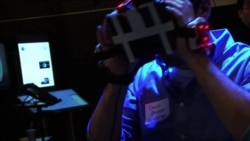The Mixed Reality Lab at University of Southern California's Institute for Creative Technologies is developing a futuristic workspace for the Navy using virtual reality.
Called E2C2 — codename "Blueshark" — the project's goal is to see how virtual reality can transform the way the Navy communicates and collaborates, elements both essential to warfare.
Recently members of the public, such as film student Dean Moro, got a sneak preview of the possibilities.
“Your eyes are fully immersed in fully stereoscopic 3-D environment and once your eyes are there, your mind is there," said Moro, utilizing a workstation replete with headset, gloves and sensors. "Your ears are there, you’re being guided by a sergeant who has a computer voice but nonetheless it works. And probably the most potent about this experience in particular is that your touch is there as well."
According to Lab director Mark Bolas, the aim is to imagine technology that will be available in 15 years so Navy ships can become lighter, better protected and provide more information to sailors to help them make better decisions.
”Instead of looking at data on 2-D screens, for example, you can have it floating as a 3-D map in front of you," he said. “If you’re going to build a ship, you better be thinking about the design of that ship at least 15 years before you build it because that’s how long it’s going to take to make it.”
Bolas and his team visited different types of ships to learn about real world problems and how virtual reality and 3-D models can help — from ship design to more operational improvements, including using strategically-placed cameras.
“In our demonstration here you can see that you can put yourself in the eyeball of a drone that’s out miles away from the ship but instead of trying to figure from some video feed what the drone is seeing you’re actually flying in that drone,” Bolas said.
The new software and hardware in the near future may also mean the end of computer monitors, he added.
“Any dumb surface can become an active surface by knowing where you’re touching by tracking the hand and knowing you’re pushing against it," he said.
For Moro the film student, the possibilities aren't limited to the armed forces. He sees a range of industries benefitting from this kind of workspace of the future.
“This is maybe a more productive way for creative people to work," he said. "Because you’re using your entire body to work instead of hunched over at a laptop typing.”
Lab director Bolas says many of these virtual reality technologies may hit the commercial market before they end up on a Navy ship.






